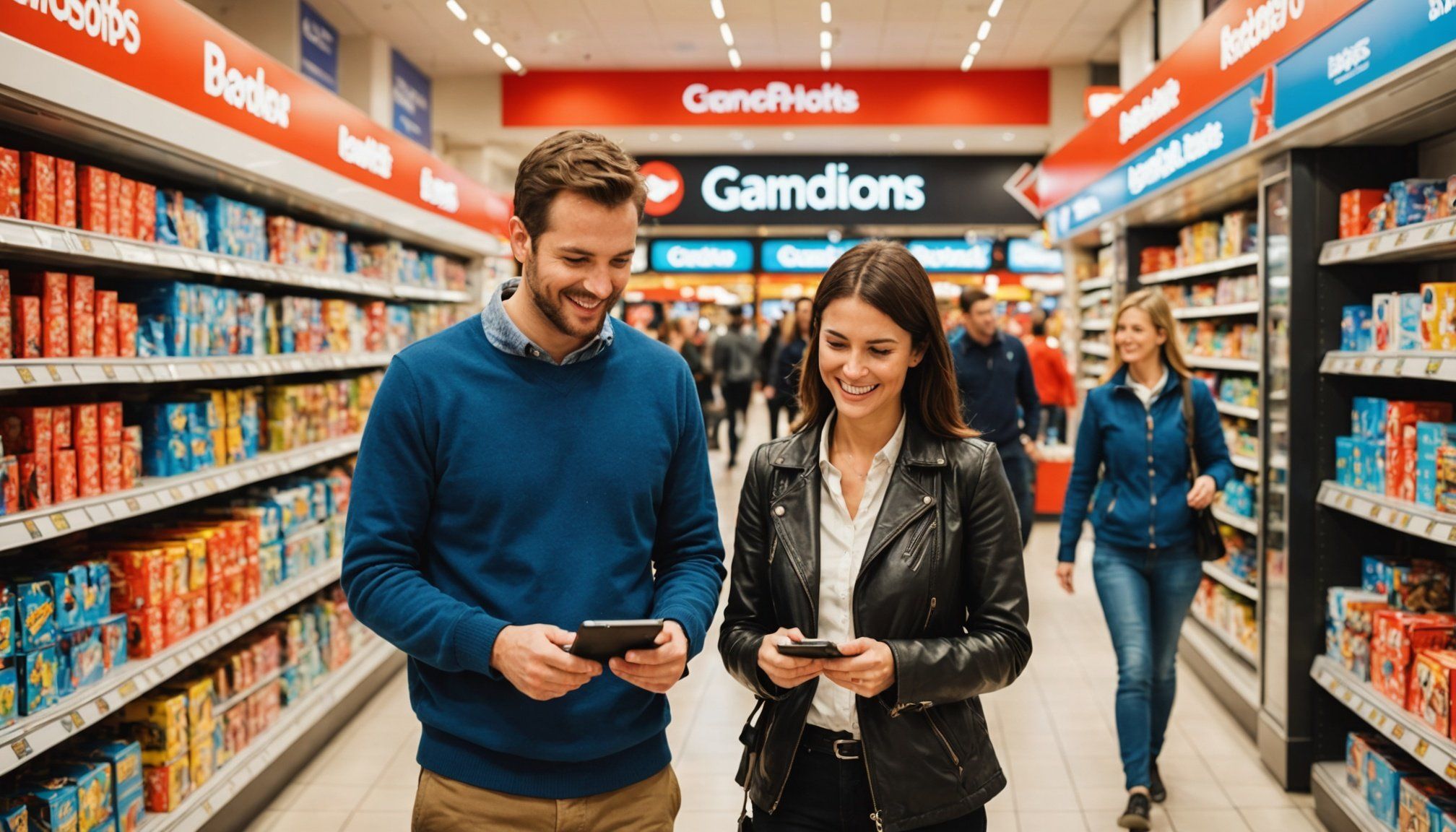Understanding Gamification in Retail
Gamification is the integration of game-like elements into non-game contexts, designed to enhance user engagement and motivation. In the retail industry, this involves employing tactics such as points, levels, and challenges to captivate customers. Retail innovation frequently embraces gamification to create interactive and enjoyable shopping experiences that can significantly influence customer engagement.
Customer behaviour is subtly influenced when gamification is used effectively. By engaging customers with interactive and competitive elements, retailers can foster a sense of achievement and reward. This, in turn, drives increased loyalty, as consumers become more eager to return and complete new challenges or redeem rewards. It’s not merely about entertainment; the end goal is to encourage repeated visits and brand affinity.
Also read : Mastering GDPR Compliance: Essential Strategies for UK E-Commerce Success
Such customer engagement tactics are increasingly important in the constantly evolving retail landscape. Trends indicate that consumers are drawn to immersive and interactive shopping experiences. Hence, implementing gamification can be crucial for staying relevant and competitive in today’s market. Retailers who succeed in leveraging these strategies tend to build strong connections with their audience, driving long-term business growth and customer loyalty.
The underlying principles of gamification create opportunities for creating meaningful consumer interactions, positioning it as a cornerstone of modern retail innovation.
In parallel : Unlocking Profit Potential: Cutting-Edge Personalization Strategies for UK Ecommerce Retailers
Successful Gamification Strategies in the UK Retail Sector
The retail landscape in the UK is rich with gamification success stories, illustrating its significant impact on customer loyalty. Several retailers stand out for their innovative use of gamification to engage customers and foster brand dedication.
Case Study: Retailer A’s Gamification Approach
Retailer A successfully integrated gamification through a creative points system, incentivising repeat purchases and social sharing. Customers earned points by completing purchase-related challenges, which could be redeemed for exclusive discounts. This not only increased sales but also boosted customer interaction on social platforms.
Case Study: Retailer B’s Loyalty Challenge
Retailer B introduced a dynamic loyalty challenge, rewarding customers for shopping milestones. This strategy utilised a tier-based system, encouraging consumers to ascend levels for greater rewards. The measurable outcome was a remarkable rise in frequent store visits, directly enhancing customer loyalty.
Case Study: Retailer C’s Reward System
Retailer C offered a unique reward system, where consumers gained badges for participating in in-store events and activities. By promoting a fun, competitive spirit, customers were motivated to return, leading to a surge in brand engagement and retention.
Each of these retailers leveraged distinctive gamification elements, crafting personalized experiences that yielded significant improvements in customer loyalty.
Practical Tips for Implementing Gamification
Implementing gamification in retail requires careful consideration and planning. Begin by understanding your customers’ motivations for engagement. Conducting surveys or focus groups can provide insights into what drives consumers to interact with your brand. Identifying these motivations is key to designing effective gamification strategies that align with customer interests.
…
Consider different categories of gamification techniques, such as points systems, challenges, and tiered rewards. Each has unique strengths and can be tailored to suit diverse retail environments. For instance, points systems can stimulate frequent purchases, while challenges might encourage participation in events or social sharing. Retailers can layer these tactics to craft a comprehensive experience.
User feedback is crucial in refining gamification elements. By actively seeking customer opinions, retailers can identify which aspects are most engaging and which may need adjustment. This iterative design process ensures that the gamification elements remain compelling and effective over time.
A couple of best practices include setting clear goals for what gamification aims to achieve, be it boosting customer loyalty or enhancing interaction, and continuously measuring outcomes through engagement metrics to gauge success. This iterative, feedback-driven approach helps maintain a dynamic and responsive gamification strategy that evolves with customer needs.
Benefits of Gamification in Retail
Integrating gamification within the retail sector offers numerous advantages. At the forefront is the boost in customer interaction and engagement levels. By incorporating game-like elements, retailers can create immersive experiences that captivate consumers and drive them to interact more frequently.
One of the critical benefits is enhanced brand loyalty. Gamification can forge a deeper connection between the consumer and the brand through personalized experiences. This emotional bond, fostered through challenges, rewards, and shared achievements, often translates into greater customer loyalty and repeat business.
Additionally, the strategic use of gamification tactics contributes to notable improvements in conversion rates and sales. By gamifying the shopping process, retailers can transform mundane tasks into exciting endeavors, encouraging customers to make purchases in order to progress to the next level or unlock a reward.
Effective measurement through engagement metrics helps businesses assess these gamification strategies. Tracking these metrics allows retailers to understand which elements resonate with consumers, enabling them to refine tactics that promote further growth. Ultimately, gamification not only enhances customer experiences but also strengthens the brand’s competitive edge and supports sustainable business growth.
Challenges of Implementing Gamification
While gamification presents many opportunities for retail innovation, its implementation is not without challenges. Retailers must be aware of potential obstacles that can hinder a successful gamification strategy.
Understanding Common Pitfalls
One common pitfall is failing to align gamification elements with customer engagement goals. Without a clear strategy, game-like features can feel irrelevant or forced, leading to disengagement. Careful planning and alignment with brand values are crucial to maintain effectiveness.
Balancing Fun with Purpose
Gamification must strike a balance between being engaging and purposeful. Overemphasizing fun can detract from the core retail goals, while being overly focused on business objectives might lessen the enjoyment. The key is to integrate compelling game elements that also serve meaningful purposes, such as enhancing customer loyalty.
Overcoming Resistance to Change
An additional challenge is overcoming resistance from both employees and customers. Employees need training to facilitate new systems, while customers might be hesitant to adapt to new experiences. Effective communication that highlights the benefits and simplicity of gamification is essential. Offering a seamless transition encourages customer loyalty and fosters a new cultural acceptance that contributes to the ongoing success of gamification efforts.
Future Trends in Gamification for Retail
As we look ahead, emerging technologies are set to revolutionize gamification experiences in retail. Augmented reality (AR) and virtual reality (VR) are at the forefront, allowing retailers to create immersive environments that engage customers like never before. For instance, AR can overlay interactive elements on physical products, enhancing a shopper’s in-store journey.
Predictions suggest that gamification will become a vital component of retail loyalty programs. With advancements in data analytics, retailers can offer highly personalized experiences, tailoring rewards to individual customer preferences. This personalization deepens customer loyalty, as consumers are more likely to engage with content that resonates personally.
To stay relevant, retailers must adapt to evolving consumer behavior in the UK market. As shoppers increasingly seek experiences over transactions, gamification aligns perfectly with this shift. Retailers should focus on holistic experiences that blend entertainment, rewards, and social elements.
Looking forward, sustainability will also influence gamification trends. Brands may leverage games to promote eco-friendly practices, offering rewards for environmentally conscious behaviors. Retailers aiming to succeed in the future must embrace these innovations, fostering both economic and ecological benefits. Thus, keeping pace with these market evolutions is crucial for maintaining competitiveness.











